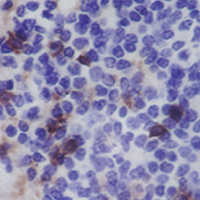Characterization of PD-1/PD-L1 immune checkpoint expression in soft tissue sarcomas

Submitted: 21 November 2020
Accepted: 25 June 2021
Published: 2 July 2021
Accepted: 25 June 2021
Abstract Views: 2120
PDF: 690
HTML: 21
HTML: 21
Publisher's note
All claims expressed in this article are solely those of the authors and do not necessarily represent those of their affiliated organizations, or those of the publisher, the editors and the reviewers. Any product that may be evaluated in this article or claim that may be made by its manufacturer is not guaranteed or endorsed by the publisher.
All claims expressed in this article are solely those of the authors and do not necessarily represent those of their affiliated organizations, or those of the publisher, the editors and the reviewers. Any product that may be evaluated in this article or claim that may be made by its manufacturer is not guaranteed or endorsed by the publisher.
Similar Articles
- G Stabellini, M Calvitti, T Baroni, L Marinucci, C Calastrini, P Carinci, E Becchetti, Glycosidases during chick embryo lung development and their colocalization with proteoglycans and growth factors , European Journal of Histochemistry: Vol. 46 No. 1 (2002)
- Yang Liu, Weichun Guo, Shuo Fang, Bin He, Xiaohai Li, Li Fan, miR-1270 enhances the proliferation, migration, and invasion of osteosarcoma via targeting cingulin , European Journal of Histochemistry: Vol. 65 No. 4 (2021)
- MG Manfredi Romanini, Histochemistry and translational medicine , European Journal of Histochemistry: Vol. 49 No. 1 (2005)
- G Anastasi, G Cutroneo, G Santoro, A Arco, G Rizzo, C Trommino, P Bramanti, Integrins, muscle agrin and sarcoglycans during muscular inactivity conditions: an immunohistochemical study , European Journal of Histochemistry: Vol. 50 No. 4 (2006)
- L. Pilloni, C. Manieli, G. Senes, D. Ribuffo, G. Faa, Merkel cell carcinoma with an unusual immunohistochemical profile , European Journal of Histochemistry: Vol. 53 No. 4 (2009)
- A Casasco, M Casasco, A Icaro Cornaglia, N Zerbinati, G Mazzini, A Calligaro, Cell kinetics in a model of artificial skin. An immunohistochemical and flow cytometric analysis , European Journal of Histochemistry: Vol. 45 No. 2 (2001)
- Manuela Monti, Gamete and embryo-fetal origins of adult diseases , European Journal of Histochemistry: Vol. 60 No. 3 (2016)
- Morium Begam, Joseph A. Roche, Damaged muscle fibers might masquerade as hybrid fibers – a cautionary note on immunophenotyping mouse muscle with mouse monoclonal antibodies , European Journal of Histochemistry: Vol. 62 No. 3 (2018)
- Maria Augusta Karas Zella, Ana Paula Martins Sebastião, Luiz Martins Collaço, Daniel Cury Ogata, Guilherme Cecchetti, Ivan José Paredes Bartolomei, Ana Maria Waaga-Gasser, Carmen Australia Paredes Marcondes Ribas, Prognostic significance of CD133 and ABCB5 expression in papillary thyroid carcinoma , European Journal of Histochemistry: Vol. 64 No. 4 (2020)
- Carolina dos Santos Jacob, Gabriela Klein Barbosa, Mariana Pasquini Rodrigues, Jurandyr Pimentel Neto, Lara Caetano Rocha, Adriano Polican Ciena, Stretching prior to resistance training promotes adaptations on the postsynaptic region in different myofiber types , European Journal of Histochemistry: Vol. 66 No. 1 (2022)
<< < 54 55 56 57 58 59 60 61 62 63 > >>
You may also start an advanced similarity search for this article.

 https://doi.org/10.4081/ejh.2021.3203
https://doi.org/10.4081/ejh.2021.3203











